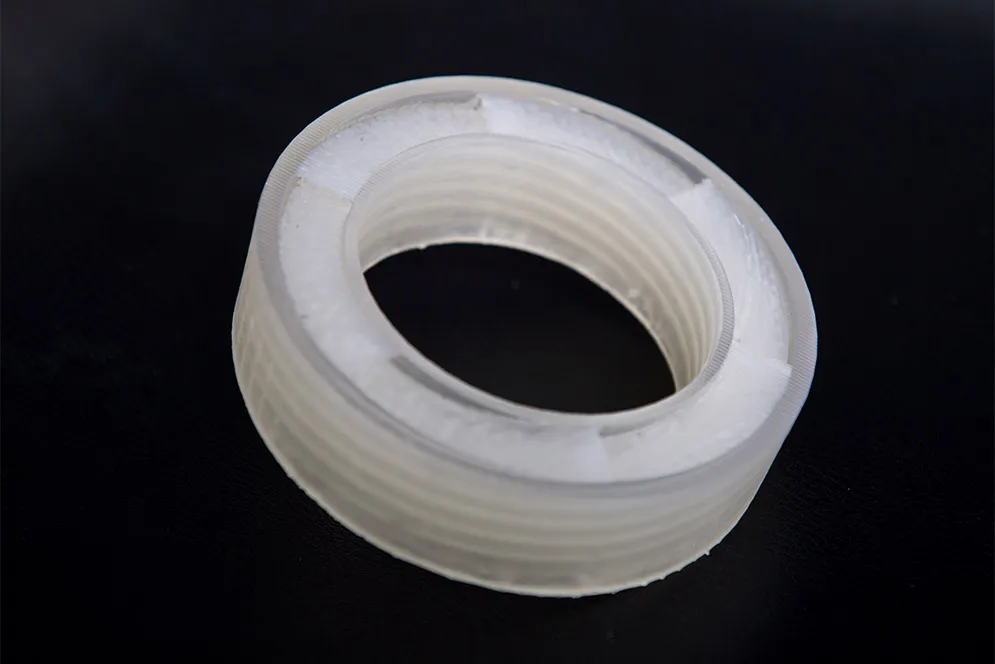This New Material Acts Like a Giant Mute Button
The metamaterial silences noise while allowing for airflow, making it a potential soundproofing material for airplanes, HVAC and more
/https://tf-cmsv2-smithsonianmag-media.s3.amazonaws.com/filer/e7/c1/e7c120e2-8fa4-496b-baec-17a318252fe1/resized-19-1023-sound-025.jpg)
Next time you’re in a restaurant or an office or the airport, look up at the ceiling. You might see cloud-like circular panels, or ribbed foam tiles or minimalist wooden slats or hanging banners that look like sails, or just the ubiquitous greyish rectangles of every high school cafeteria in America. Though they may be aesthetically pleasing (or not), these materials are actually designed to absorb sound and make the room quieter.
We may not notice, but much of our environment is in fact built or designed to reduce the noise of the modern world. Thick curtains help create the hush in fancy law offices. Heavy wooden front doors keep some of the street noise from houses.
Now, researchers from Boston University have created a new kind of material that can block sound while allowing for airflow. It’s what’s known as a “metamaterial”—a material that’s been engineered to have properties not found in nature. The tiny helical pattern of plastic inside the ring-shaped shell sends incoming soundwaves back to their origin, thereby blocking sound but not air.
“The question of whether we can silence sound waves while maintaining airflow has inspired the research community for decades,” says Xin Zhang, a professor at Boston University’s College of Engineering, who co-led the project and co-authored a paper about the material that was recently published in the journal Physical Review B.
Allowing for airflow is key to some potential uses for the material. You can’t put a traditional silencing material on a jet engine or a drone and still allow it to fly. But the new 3D-printed metamaterial could potentially be used to curtail noise from aircraft, fans and HVAC systems without interfering with the airflow.
The donut-shaped design of the material is potentially “very useful,” says Kathryn Matlack, a professor of mechanical science and engineering at the University of Illinois at Urbana-Champaign, who studies acoustic metamaterials, since “most sound attenuating materials are solid and prevent airflow.”
To test the metamaterial in the lab, the Boston University researchers attempted to silence a loudspeaker. They sealed the loudspeaker to one end of a PVC pipe and attached a ring of the metamaterial to the other. Then they hit play.
Silence.
Looking into the PVC pipe, they could see the loudspeaker’s subwoofers throbbing. But they couldn’t hear a thing. The material, by their calculations, blocked 94 percent of sound.
It was like pushing the “mute” button, the researchers said.

The metamaterial is also cheap to make and lightweight, says Reza Ghaffarivardavagh, a PhD student in mechanical engineering at Boston University.
“These features open up opportunities for new and exciting applications,” he says.
The material could reduce the noise of an MRI machine, sometimes likened to a jackhammer. It could be used as a sound barrier against traffic. It could also be used in place of traditional soundproofing materials like acoustic tile or curtains. The outer shape doesn’t have to be a ring; it can be anything from a hexagon to a square, so clients could potentially order aesthetically pleasing custom sound walls for restaurants or theaters.
A quieter world won’t just be more relaxing. It could also be healthier. There’s growing evidence that “environmental noise pollution” has negative effects on our bodies and minds, raising the risk of everything from heart disease to cognitive impairment. Last year, the World Health Organization released guidelines to support policy-makers in reducing environmental noise from sources like cars, trains and wind turbines. Excessive noise is also bad for non-human animals. Ongoing research is investigating how noise pollution reduces biodiversity.
Zhang says the metamaterial has generated interest from a number of organizations across different industries, including manufacturing, energy and auto-making.
“We are now working to address the viability of each potential application and project,” she says. “I am hopeful that we will see a commercial application in some form within the next few years.”
/https://tf-cmsv2-smithsonianmag-media.s3.amazonaws.com/accounts/headshot/matchar.png)


/https://tf-cmsv2-smithsonianmag-media.s3.amazonaws.com/accounts/headshot/matchar.png)